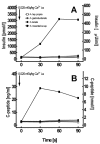Diagnosis and localization of insulinoma after negative laparotomy by hyperinsulinemic, hypoglycemic clamp and intra-arterial calcium stimulation
- PMID: 17491664
- PMCID: PMC1783532
- DOI: 10.1900/RDS.2004.1.42
Diagnosis and localization of insulinoma after negative laparotomy by hyperinsulinemic, hypoglycemic clamp and intra-arterial calcium stimulation
Abstract
A 40-year-old woman with recurrent episodes of hypoglycemia was referred because of suspected insulinoma. Prolonged fasting was discontinued after 24 h due to symptomatic hypoglycemia (29 mg/dl, glucose/insulin-ratio 0.34). Magnetic resonance tomography showed a small 0.3 cm lesion in the body of the pancreas. During subsequent surgery a pancreatic tumor could not be detected, neither by manual palpation nor intraoperative ultrasonography. A hyperinsulinemic, sequentially eu- and hypoglycemic clamp confirmed the biochemical diagnosis of endogenous hyperinsulinemia and intra-arterial calcium stimulation localized calcium responsive tissue in the feeding distribution of the superior mesenteric artery. An octreotide scan was negative. During relaparotomy, six weeks after the initial surgery, the pancreatic body and tail were resected and a approximately 1 cm non-malignant insulinoma was found. Although the use of highly sensitive, and more sophisticated and expensive methods for the diagnosis and localization of insulinomas are not generally suggested, we recommend application of intra-arterial calcium stimulation if the tumor is not detected using conventional diagnostic procedures.
Figures


Similar articles
-
Insulinoma Due to Multiple Pancreatic Microadenoma Localized by Multimodal Imaging.J Clin Endocrinol Metab. 2016 Oct;101(10):3559-3563. doi: 10.1210/jc.2016-2717. Epub 2016 Aug 9. J Clin Endocrinol Metab. 2016. PMID: 27504852 Free PMC article.
-
Insulin responses to selective arterial calcium infusion under hyperinsulinemic euglycemic glucose clamps: case studies in adult nesidioblastosis and childhood insulinoma.Endocr J. 2007 Feb;54(1):27-33. doi: 10.1507/endocrj.k06-104. Epub 2006 Oct 20. Endocr J. 2007. PMID: 17053293
-
Accurate localization of an insulinoma by preoperative selective intra-arterial calcium injection and intraoperative glucose monitoring.Pediatr Surg Int. 2000;16(1-2):118-20. doi: 10.1007/s003830050036. Pediatr Surg Int. 2000. PMID: 10663858
-
Surgical aspects of hyperinsulinemic hypoglycemia.Endocrinol Metab Clin North Am. 1999 Sep;28(3):533-54. doi: 10.1016/s0889-8529(05)70087-6. Endocrinol Metab Clin North Am. 1999. PMID: 10500930 Review.
-
Localization of small sized insulinoma by means of combining arteriography with CT: a case report and review of the literature.Hepatogastroenterology. 2010 Nov-Dec;57(104):1579-83. Hepatogastroenterology. 2010. PMID: 21443124 Review.
Cited by
-
Diagnosis and management of insulinoma.World J Gastroenterol. 2013 Feb 14;19(6):829-37. doi: 10.3748/wjg.v19.i6.829. World J Gastroenterol. 2013. PMID: 23430217 Free PMC article. Review.
-
Essentials of Insulinoma Localization with Selective Arterial Calcium Stimulation and Hepatic Venous Sampling.J Clin Med. 2020 Sep 25;9(10):3091. doi: 10.3390/jcm9103091. J Clin Med. 2020. PMID: 32992761 Free PMC article. Review.
-
Enucleation in pancreatic surgery: indications, technique, and outcome compared to standard pancreatic resections.Langenbecks Arch Surg. 2011 Dec;396(8):1197-203. doi: 10.1007/s00423-011-0801-z. Epub 2011 May 8. Langenbecks Arch Surg. 2011. PMID: 21553230
-
[Invasive diagnostic procedures for insulinomas of the pancreas].Radiologe. 2009 Mar;49(3):224-32. doi: 10.1007/s00117-008-1786-7. Radiologe. 2009. PMID: 19198794 German.
References
-
- Service FJ. Hypoglycemic disorders. N Engl J Med. 1995;332:1144–1152. - PubMed
-
- Nauck MA, Baum F, Seidensticker F, Roder M, Dinesen B, Creutzfeldt W. A hyperinsulinaemic, sequentially eu- and hypoglycaemic clamp test to characterize autonomous insulin secretion in patients with insulinoma. Eur J Clin Invest. 1997;27:109–115. - PubMed
-
- Service FJ, Natt N. The prolonged fast. J Clin Endocrinol Metab. 2000;85:3973–3974. - PubMed
-
- Doherty GM, Doppman JL, Shawker TH, Miller DL, Eastman RC, Gorden P, Norton JA. Results of a prospective strategy to diagnose, localize, and resect insulinomas. Surgery. 1991;110:989–996. - PubMed
LinkOut - more resources
Full Text Sources
